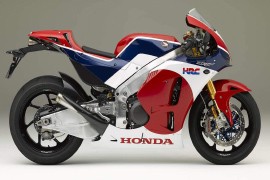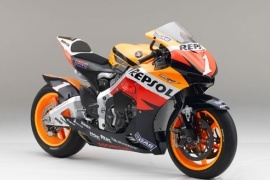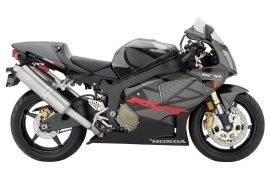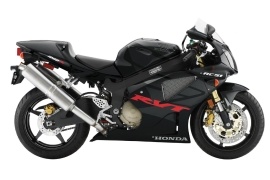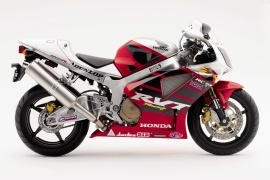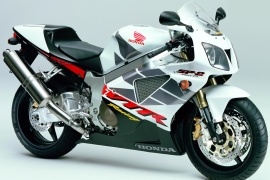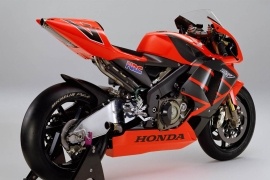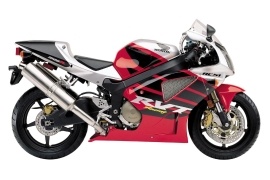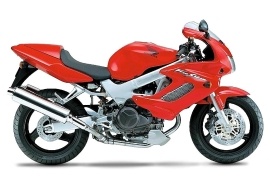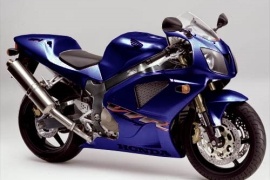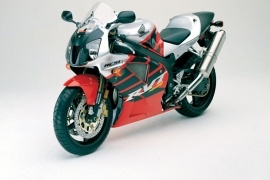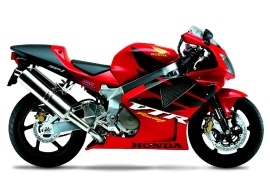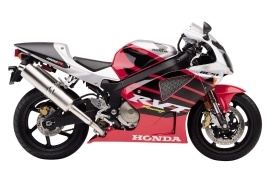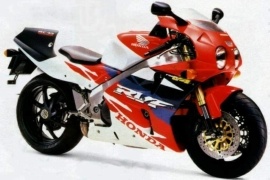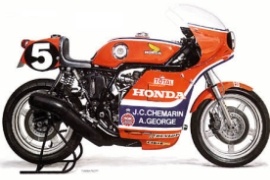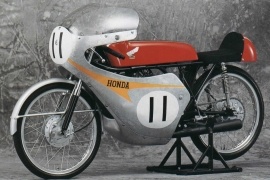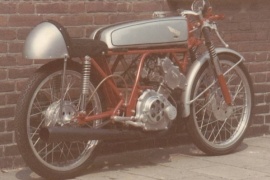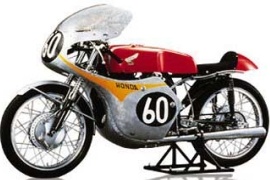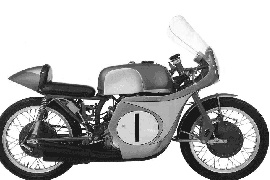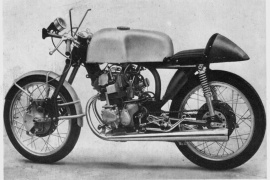HONDA RC Models/Series Timeline, Specifications & Photos
First production year: 1959
The Honda RC213V was a racing motorcycle manufactured by Honda Racing Corporation (HRC) to compete in the MotoGP series in the 2012 season. The rules allowed machines with 1,000 cc engines, a limit of four cylinders, and an 81 mm bore.
In 2015, Honda launched the RC213V-S 1000, a limited-run street-legal MotoGP replica that shared 80 percent of its parts with the MotoGP version. Also, Honda made a kit upgrade package available that allowed riders to improve the bike for on-road use.
The differences between the RC213V and RC213V-S included steel valve springs instead of pneumatic springs, stainless steel brakes instead of carbon, a six-speed sequential manual transmission instead of the seamless shift unit, larger 17-inch Marchesini wheels, and a larger steering angle.
Some additional features for the road-legal machine included a headlight, a taillight, license plate lights, turn signals, rearview mirrors, a speedometer, a muffler with a catalytic converter, a horn, a Honda smart key, an electric starter, and a side stand.
The bike used a telescopic fork on the front and a Pro-Link shock absorber on the rear for suspension. As for braking power, the model packed two discs with hydraulic calipers on the front and a single disc with a hydraulic caliper on the rear.
The 2015 Honda RC213V-S 1000, with a 999cc V4 liquid-cooled engine, delivered 159 hp at 11,000 rpm and 102 Nm (75 lb-ft) torque at 10,500 rpm, and with the power kit on; it offered a maximum power of 215 hp at 13,000 rpm and 118 Nm (87 lb-ft) torque at 10,500 rpm.
The Honda RC212V was a Japanese racing motorcycle created by Honda for road racing in the 800cc MotoGP series. The bike was developed by Honda Racing Corporation (HRC) and was officially introduced in 2006 as a replacement for the RC211V.
The RC212V racing machine started officially racing in the 2007 season. It was powered by an 800cc liquid-cooled four-stroke DOHC four-valve engine placed in an all-new chassis, focusing on mass centralization and handling.
In 2007, The issue with Honda's GP machine was which team and rider would receive the best parts and if performance differences were due to the rider rather than the machine. After a few rounds, the riders did not achieve the results, so the leading HRC chief admitted that they had made a mistake in developing the RC212V.
In 2008, Honda used pneumatic valve springs and a new chassis. The 2008 model with pneumatic valves was only available to the Repsol team, which in testing, it proved to be very problematic.
In 2009, Pedrosa and Dovizioso were the factory team riders, while Elias, De Angelis, De Puniet, and Yuki Takahashi were the Stateline team riders. The 2009 racing machine was similar to the 2008 model, and all six RC212V machines used pneumatic valve powerplants.
In 2010, Pedrosa and Dovizioso were again the factory team riders, while Hiroshi Aoyama, de Puniet, Melandri, and Marco Simoncelli were the Stateline team riders. The riders used Ohlin suspension, an updated electronic system, and a shorter bike with a higher center of gravity.
For 2011, the frame geometry and rigidity were the same as the previous model, with an improvement to the seamless transmission, making the machine an evolution of the 2010 model.
In 2006, Honda released the RVT1000R, a robust and reliable racing machine built upon the strengths of the previous models, with excellent power delivery, smooth throttle response, and great handling.
The bike was first introduced in 2000 as a competitor in the Sportbike World Championship. It was known as the RVT1000R in the United States market and as the VTR1000 SP2 in the Australian and European markets.
From 2000 to 2001, the RVT1000R was designated as the SP1, and from 2002 to 2006, it was designated as the SP2 due to its upgraded fuel injection system with 12-hole injectors and modified suspension system.
The 2006 Honda RVT1000R was the last model of the series and packed many similarities with its predecessors. The bike was powered by the same 999cc V-twin liquid-cooled engine, delivering the same output power of 136 hp at 9,500 rpm and 105 Nm (77lb-ft) torque at 8,000 rpm.
Also, the suspension was retained from previous models without any changes. The front end was handled by a 43 mm adjustable inverted fork with 130 mm of wheel travel, and the rear was operated by an adjustable Pro-Link, gas-charged shock absorber with 120 mm wheel travel.
The stopping power was the same as its predecessors, with two 320 mm discs bolted on the wheel, engaged by four-piston calipers. A 220 mm disc with a dual-piston caliper handled the rear wheel and offered strong braking performance.
In 2005, Honda released the RVT1000R, a powerful racing motorcycle that debuted in 2000 as a competitor in the Superbike World Championship. The bike was known as the RVT1000R in the American market and VTR1000 SP2 in the European and Australian markets.
The RC51 motorcycle was manufactured between 2000 and 2006, while the first two models were designated SP1 and later models were designated SP2. The latest 2002 to 2006 models featured an updated fuel injection system with 12 laser-drilled holes injectors and a modified suspension system.
Honda stopped the official support for superbike racing in 2003, and when superbike rules were changed to allow 1,000cc four-cylinder motorcycles, the RVT1000R was replaced by the Honda CBR1000RR Fireblade.
In 2005, the Japanese motorcycle maker launched the Honda RVT1000R, a powerful racing machine built upon previous models' strengths. The machine was powered by a 999cc four-stroke V-twin liquid-cooled engine fed by an electronically controlled fuel injection system, fueling two injectors per cylinder.
With 136 hp on tap at 9,500 rpm and 105 Nm (77 lb-ft) of torque at 8,000 rpm, the engine transferred the power to the rear wheel through a six-speed transmission, launching the bike to a top speed of 271 kph (171 mph).
The braking performance was carried from the previous models, with a four-piston caliper and a 320 mm disc mounted on the front wheel, while the rear packed a 220 mm disc with a dual-piston caliper for strong stopping power.
The Honda RC51 was a racing machine manufactured by Honda to compete in the Superbike World Championship. The bike was known as the RVT1000R in the American market and VTR1000 SP1 in the European and Australian markets.
The RVT1000R motorcycle was manufactured from 2000 to 2006 and was powered by a 999cc V-twin liquid-cooled engine with dual fuel injectors and four valves per cylinder. The power was delivered to the rear wheel through a close-ratio six-speed manual transmission, highly geared for top-speed performance.
The first two models were designated as SP1, while the models manufactured from 2002 until 2006 were designated as SP2 and featured an updated fuel injection system with 12 laser-drilled holes injectors for enhanced throttle response and an upgraded suspension system.
In 2003, Honda interrupted official support for superbike racing. When superbike rules were changed to allow 1,000 cc four-cylinder machines, the Japanese maker replaced the RC51 with the CBR1000RR Fireblade.
In 2004, Honda released the RVT1000R, a racing machine that shared many similarities with previous models. The 2004 RVT1000R was built upon the strengths of its predecessors and offered an excellent riding experience with massive power delivery and responsive handling.
The 2004 Honda RVT1000R had a 999cc four-stroke V-twin liquid-cooled engine controlled by a Programmed Fuel Injection (PGM-FI) system, boasting 136 hp at 9,500 rpm and 105 Nm (77 lb-ft) torque at 8,000 rpm.
The Honda RC51 was a racing machine manufactured by Honda from 2000 to 2006, also known as the RTV1000R in the American market and VTR1000 SP1 in the European and Australian markets.
The 2000 and 2001 models were designated the SP1 and powered by a 999cc V-twin engine with dual fuel injectors and four valves per cylinder, delivering the power to a close-ratio six-speed manual transmission.
The 2002 to 2006 models were designated as the SP2 and featured several modifications, such as an updated fuel injection system with 12 laser-drilled holes for enhanced throttle response and a revised suspension system.
In 2003, Honda released the RVT1000R, a racing machine that retained many of the same features and specifications as the previous model and introduced different color combinations, such as Classic Red with Black and Silver with Black.
The bike's twin-spar aluminum frame was fitted with an adjustable 43 mm cartridge-type fork on the front and an adjustable Pro-Link gas-charged shock absorber on the rear for excellent suspension performance and handling.
In the braking department, the RVT1000R featured five-spoke lightweight aluminum wheels fitted with four-piston calipers, two 320 mm discs on the front, and a single-piston caliper with a 220 mm disc on the rear for strong stopping power.
The 2003 Honda RVT100R was set in motion by a 999cc four-stroke-V-twin liquid-cooled engine that boasted 136 hp with maximum potency at 9,500 rpm and 105 Nm (77 lb-ft) torque at 8,000 rpm.
The Honda RC211V race motorcycle was developed by Honda Racing Corporation (HRC) in 2001 to replace the two-strokes Honda NSR500. The bike was powered by a 990cc four-stroke engine.
When it debuted in 2002, Honda and Valentino Rossi won the constructor's championship with more than 100 points over its nearest rival. Over the season, the bike went through minor modifications and packed a handlebar-mounted power management system with three race settings.
In 2003, the RC211V underwent several performance modifications that increased power from 200 to 240 hp but also introduced the traction control system, enhancing its handling capabilities.
In 2004, the racing machine underwent other modifications, including a link inverted rear suspension and a new exhaust system introduced at the Sachsenring round.
In 2005, the Japanese manufacturer lost the constructor's championship in the premier class for the first time in four years. The RC211V chassis was constantly revised and rewelded, while after the race at Brno, Honda tested an improved bike, after that known as the Brno bike.
In 2006, the RC211V machine came in three versions: the Brno bike ridden by Hayden, a 2006 motorcycle with a unique chassis for Pedrosa, and a 2006 model for Melandri, Elias, Stoner, and Tamada.
In addition, in five seasons of MotoGP racing, the RC211V was the winner of 48 races out of 82, the winner of three World Championships, and gathered four constructors' titles.
In 2002, Honda launched the RVT1000R, a racing machine that debuted in 2000, also known as the RC51 and VTR1000 SP1, in the European and Australian markets. The bike was manufactured from 2000 to 2006 and was powered by a 999cc V-twin engine.
The RVT1000R was designed for racing in the Superbike World Championship and was fitted with a highly geared transmission for top-speed performance. The model manufactured from 2002 to 2006 was designated as the SP2.
The 2002 machine featured several improvements, such as larger fuel injection throttle bodies, two fuel injectors for each cylinder with 12 laser-drilled holes for more responsive throttle response, and newly designed exhaust ports for increased engine performance.
The bike was fitted with new five-spoke aluminum wheels with forward-facing v-shaped spokes for increased aerodynamic capabilities, wrapped with next-generation Dunlop D208 tires.
Additional features of the bike included a distinctive bodywork with a dual-headlight design separated by a ram-air duct, a narrow fuel tank, and a single-piece tail section. In case of a tip over, the fuel injection system was fitted with a unique bank-angle sensor that shuts off the fuel supply.
Also, the bike packed a lightweight instrument cluster that included an LCD tachometer, speedometer, fuel indicator, odometer, temperature gauge, and trip meter. Also, the handlebar switches used internationally approved ISO graphic symbols.
As for power, the 2002 Honda RVT1000R boasted 136 hp with a peak at 9,500 rpm and 105 Nm (77 lb-ft) of torque at 8,000 rpm from a 999cc four-stroke V-twin liquid-cooled engine.
The Honda VTR1000F was a sports motorcycle manufactured by Honda from 1997 to 2005, known as the Firestorm worldwide and as the Superhawk in the United States market. The bike was powered by a 996cc V-twin liquid-cooled engine and a Honda Multi-Action System (HMAS) suspension.
The VTR1000F packed several new design concepts, including a semi-pivotless frame with the engine used as a stressed chassis member and the swingarm bolted directly to the powerplant.
In addition, other innovations were used on the bike, such as a single-casting engine case, side radiators, connecting rods with cap screws instead of nuts, and the largest intake valves and carburetors ever fitted on a production motorcycle at the time.
In 2001, Honda launched the VTR1000F Firestorm, a sports motorcycle that introduced several modifications and upgrades, including a larger 19-liter fuel tank, internal changes to the front suspension, and black-finished wheels.
In addition, the bike was fitted with smaller indicator lights, a less extreme riding position thanks to the raked clip-on handlebar, and a new LCD with a fuel level indicator, engine temperature, an odometer, and a clock.
The Honda Ignition Security System (HISS) became a standard option, while the US version of the VTR1000F was not fitted with the 19-liter larger fuel tank and retained the 16-liter original tank.
For power, the 2001 Honda VTR1000F Firestorm offered excellent performance from the 996cc four-stroke V-twin liquid-cooled engine, with 110 poneys at 9,000 rpm and 97 Nm (72 lb-ft) of torque at 7,000 rpm.
The Honda RC51, known as the RVT1000R in the United States market and the VTR1000 SP1 in the European and Australian markets, was a V-twin-powered sports machine manufactured by Honda from 2000 to 2006.
The RVT100R motorcycle was explicitly designed to compete in the Superbike World Championship. The 2000 and 2001 machines were designated SP1, while the 2002 to 2006 models had updated fuel injection and suspension systems and were designated SP2.
In 2001, the Japanese maker released the second-year model of the RVT1000R, a sports motorcycle made for racing purposes and a successor to the VTR1000F Superhawk. The bike came in the same package as the first model without any modifications.
It features the same twin-spar aluminum frame with a 43 mm adjustable inverted cartridge-type fork handling the front suspension and an adjustable Pro-Link gas-charged shock absorber cushioning the rear wheel.
The bike rolled on six-spoke lightweight cast aluminum wheels fitted with a 320 mm disc, a four-piston caliper on the front, and a dual-piston caliper with a 220 mm disc on the rear, providing strong stopping power.
A 999cc four-stroke V-twin liquid-cooled engine powered the machine and offered strong power delivery with a force of 136 hp at 9,500 rpm and 105 Nm (77 lb-ft) of torque at 8,000 rpm.
The power was sent to the rear wheel through a six-speed manual transmission and chain final drive, pushing the 2001 Honda RVT1000R to a top speed of 275 kph (171 mph).
In 2000, Honda released the RVT1000R, a sports machine known as the RC51, and VTR1000 SP1 in Australian and European markets. The model had a V-twin power generator and was produced between 2000 and 2006.
Honda manufactured the RVT1000R to compete in the Superbike World Championship. The models manufactured between 2000 and 2001 were called the SP1, and the 2002 to 2006 machines were called SP2, with updated suspension and fuel injection systems.
In 2001, Honda released the RVT1000R, a sports motorcycle in its second year of production. The 2001 RVT1000R came without any modification compared to the previous model. It was the successor to the VTR1000F and was designed for racing purposes.
A 43 mm adjustable inverted cartridge-type fork was handling the front suspension. An adjustable Pro-Link gas-charged shock absorber cushioned the rear wheel, all mounted on a twin-spar aluminum frame.
The bike came from the factory with six-spoke lightweight cast aluminum wheels fitted with a 320 mm disc, a four-piston caliper on the front, and a dual-piston caliper with a 220 mm disc on the rear, providing strong stopping power.
The power was generated by a 999cc four-stroke V-twin liquid-cooled engine offering strong power delivery equivalent to 136 hp at 9,500 rpm and 105 Nm (77 lb-ft) of torque at 8,000 rpm.
The power generated by the one-liter V-twin engine went through a six-speed manual transmission and chain final drive, pushing the 2001 Honda RVT1000R RC51 to a top speed of 275 kph (171 mph).
The Honda VTR1000F was a sports motorcycle manufactured by Honda from 1997 to 2005, powered by a 996cc liquid-cooled V-twin engine. The bike was known worldwide as the Firestorm, while in the United States market was known as the Superhawk.
The first model was introduced in 1997. It featured a Honda Multi-Action System (HMAS) suspension and several new design concepts, like a semi-pivotless frame that used the engine as a stressed member and the swingarm bolted directly to it.
Other innovations included side radiators, a single-casting engine case, connecting rods with cap screws, the largest 38 mm intake valves, and the largest carburetors Honda had ever used on a production machine at the time.
The twin-spar aluminum frame was fitted with an adjustable 41 mm cartridge-type fork on the front with 109 mm of wheel travel and an adjustable Pro-Link shock absorber on the rear for excellent suspension performance and handling.
In the safety department, the bike was fitted with four-piston calipers and two 296 mm discs bolted to a three-spoke cast aluminum wheel acting as front-stopping power. The rear wheel was handled by a 220 mm disc with a single-piston caliper.
In the power department, the 2000 Honda VTR1000F Firestorm boasted 110 hp with a peak at 9,000 rpm and 97 Nm (72 lb-ft) of torque at 7,000 rpm from a 996cc liquid-cooled V-twin engine fed by two constant velocity carburetors.
With a dry weight of 192 kg (423 lbs) and six-speed manual transmission, the 2000 Honda VTR1000F Firestorm reached a top speed of 248 kph (154 mph).
The Honda RVT1000R, also known as the VTR1000 SP1 in the European and Australian markets, was a V-twin sports motorcycle manufactured by Honda from 2000 to 2006. It was a racing superbike with a highly geared transmission for top-speed performance.
The RVT1000R was designed to be used by Hoanda's racing team in the Superbike World Championship. The model manufactured from 2000 to 2001 were designated as the SP1 and the models made from 2002 to 2006 were designated as the SP2, with updated fuel injection and suspension systems.
The bike had a twin-spar aluminum alloy frame that supported the 999cc V-twin engine with two fuel injectors and four valves per cylinder, boasting 136 hp at 9,500 rpm and 105 Nm (77 lb-ft) torque at 8,000 rpm.
With a six-speed manual transmission and a dry weight of 196 kg (432 lbs), the 2000 Honda RVT1000R reached a top speed of 275 kph (171 mph).
The front suspension was handled by an adjustable 43 mm inverted cartridge-type fork with 130 mm wheel travel, while the rear was operated by an adjustable Pro-Link gas-charged shock absorber with 120 mm wheel travel.
In the braking department, a four-piston caliper with a 320 mm disc handled the front wheel stopping power, while the rear wheel braking performance was operated by a dual-piston caliper with a 220 mm disc.
Also, in 2000, the RVT1000R won the World Superbike Championship with Colin Edwards behind bars and riding for the Castrol team.
The Honda RVF750R, also known as the RC45, was a fully faired racing machine created by the Japanese manufacturer for the Superbike World Championship and as a successor to the VFR750R, also known as the RC30.
Like the VFR750R, the RVF750R model packed a V4 DOHC liquid-cooled engine with gear-driven cams and a single-sided swingarm, but also an electronic fuel injection system similar to the one used on the 1992 NR750 model.
After the RC30 showed its age and was beaten by Ducati models, Honda redesigned the RC30 with more technology from the RVF endurance racer and launched the RC45 machine. The RVF750R was made in only 200 units worldwide, with 50 models imported into the United States.
The 1994 Honda RVF750R machine had a lightweight diamond twin-spar aluminum frame with a 41 mm USD adjustable fork handling the bike's front suspension and a Pro-Link adjustable shock absorber operating the rear suspension.
For braking purposes, the bike packed four-piston calipers with two 310 mm discs mounted on the front wheel and a dual-piston caliper with a 220 mm disc on the rear wheel for strong stopping power.
The bike was fitted with a 749cc V-four liquid-cooled engine handled by a Programmed Fuel Injection (PGM-FI) system, delivering 119 hp at 12.000 rpm and 75 Nm (56 lb-ft) of torque at 10,000 rpm.
The power produced by the engine was sent to the rear wheel thanks to a six-speed manual transmission that pushed the bike to a top speed of 259 kph (161 mph).
The Honda RCB1000 is a sport motorcycle produced by Honda for only 4 years, between 1976 and 1980.
Kept in production for only two years, between 1962 and 1964, the Honda RC 112 sport motorcycle was able to develop 10 horsepower at 17500 rpm, being equipped with a 9 speed gearbox.
Manufactured in 1962 in order to participate to race competitions, the RC110 has a single cylinder engine with a bore and stroke of 40x39, a compression ratio of 10.5:1 and an output of 9.5bhp at 14,000rpm.
Developing 23 horsepower at 14000 rpm, the Honda RC 143 sport motorcycle helped Tom Phillis achieve the first World Championship victory in 1961.
Even if it was produced for only one year, the 1959 model of the Honda sport bike RC 160 was able to reach a top speed of 200 km/h, mostly thanks to its four-valve engine which developed 35 horsepower at 14000 rpm.
The Honda RC142 was a sports bike manufactured by Honda in 1959, part of the RC series that included motorcycles with different displacement engines. Also, the RC142 was designed for racing.
The 1959 Honda RC142 featured a lightweight and compact design, optimized for racing purposes, with a tubular steel frame that offered excellent rigidity with the weight maintained on the low side. Also, the bike packed a streamlined fairing and aerodynamic bodywork that reduced drag force and enhanced its overall performance.
As suspension, the bike had a telescopic fork on the front with dual shock absorbers on the rear for precise handling and stability. The RC142 was fitted with both front and back drum units for braking purposes, which were typical for that era.
The Honda RC142 was a successful machine in racing competitions, such as the Isle of Men TT races, where Honda proved their engineering prowess and made the brand a real force in motorcycling racing.
The bike was powered by a 124cc four-stroke twin-cylinder engine with a Single Overhead Camshaft (SOHC) design and a twin-valve setup. The machine was designed for high-performance racing, focusing on power delivery and reliability.
Overall, the 1959 Honda RC142 was a racing machine that contributed to Honda's racing heritage. Its powerful yet small engine, lightweight design, and racing-oriented features impacted the motorcycle racing world during its era.
